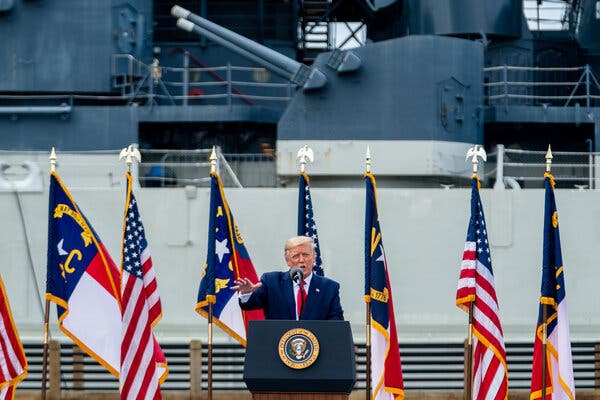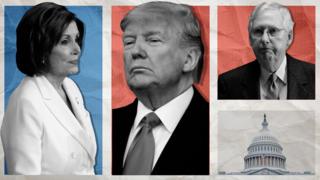Advertisement
The president is attempting to overtake his Democratic challenger with a strategy of racial polarization in heavily white Midwestern states, even as Democrats make inroads in the Republican-leaning South and West.

A presidential campaign long muffled by the coronavirus pandemic will burst into a newly intense and public phase after Labor Day, as Joseph R. Biden Jr. moves aggressively to defend his polling lead against a ferocious onslaught by President Trump aimed chiefly at white voters in the Midwest.
Private polls conducted for both parties during and after their August conventions found the race largely stable but tightening slightly in some states, with Mr. Trump recovering some support from conservative-leaning rural voters who had drifted away over the summer amid the worsening pandemic. Yet Mr. Biden continues to enjoy advantages with nearly every other group, especially in populous areas where the virus remains at the forefront for voters, according to people briefed on the data.
No president has entered Labor Day weekend — the traditional kickoff of the fall campaign — as such a clear underdog since George Bush in 1992. Mr. Trump has not led in public polls in such must-win states as Florida since Mr. Biden claimed the nomination in April, and there has been little fluctuation in the race. Still, the president’s surprise win in 2016 weighs heavily in the thinking of nervous Democrats and hopeful Republicans alike.
Mr. Trump’s effort to revive his candidacy by blaming Mr. Biden’s party for scenes of looting and arson in American cities has jolted Mr. Biden into a more proactive posture, one that some Democrats have long urged him to adopt. The former vice president spent last week pushing back forcefully on Mr. Trump’s often false attacks, after encouragement from allies including former Secretary of State John F. Kerry, whose 2004 presidential campaign faltered in the face of a concerted smear campaign about his Vietnam War service.
Both parties see Mr. Trump with a narrow path to re-election that runs through heavily white states like Wisconsin and Minnesota, where his strategy of racial division could help him catch Mr. Biden. Yet the president is also on defense in diverse Southern and Western states he carried in 2016, including Florida, North Carolina, Arizona and Georgia.
Two Republican former governors, Tim Pawlenty of Minnesota and Scott Walker of Wisconsin, said that Mr. Biden had entered the fall with slight advantages in their states but that the race could easily turn.
“Can Trump win back some of those voters in the second and third ring of suburbs?” said Mr. Pawlenty, noting that those areas had trended toward Democrats. “They’re really unsettled by the violence, but the question is if it’s enough to reverse recent voting patterns.”
Mr. Walker said Mr. Trump’s hopes in Wisconsin increasingly hung on the three presidential debates, which will “have an impact if it worries voters about Biden.”
A consistent challenge for Mr. Trump has been his unwillingness, or inability, to drive a focused political message rather than becoming engulfed in less favorable debates, like his ongoing tirade against a report that he belittled American service members. His campaign also appears to be facing a significant financial crunch and has largely ceased advertising on television even as Mr. Biden begins to spend heavily from his war chest after raising about $365 million in August.
The former vice president is airing tens of millions of dollars in ads rebutting Mr. Trump’s law-and-order-themed attacks, though some in his campaign are hoping to quickly return the focus to the coronavirus and the economy.
Mr. Biden is slated to visit Pennsylvania on Monday and Michigan on Wednesday, his third and fourth trips to critical swing states since last week, when he traveled to Pittsburgh for a speech rebutting Mr. Trump’s attacks and then to Kenosha, Wis., to meet with the family of Jacob Blake, a Black man shot by the police, and with others.
Morgan Jackson, a top adviser to Roy Cooper, the Democratic governor of North Carolina, said his surveys after the conventions indicated that Mr. Biden had a steady, if modest, advantage in the state and that the small number of swing voters were chiefly concerned about the pandemic.
“Charlotte is not burning,” Mr. Jackson said. “That’s a conversation taking place on Fox News but nowhere in reality here.”
Senator Amy Klobuchar of Minnesota, the former Democratic presidential candidate, said Mr. Biden had so far struck the right chord for a Midwestern audience.
“Joe Biden’s words in Pittsburgh — that he both supports police reform and condemns lawless looting — were exactly what people needed to hear in Minnesota and across the country,” she said.
Many Democrats in battleground states are anxious to see Mr. Biden visit in person — particularly in Wisconsin, where Hillary Clinton’s 2016 absence lives in political infamy.
Representative Mark Pocan, a Wisconsin Democrat, said he had “been promised Biden several more times” after the Kenosha trip. He said Republican attacks on Mr. Biden’s limited travel had penetrated with some voters.
“I’ve heard some people who don’t live and breathe politics saying, ‘Oh, looks like Democrats aren’t going to come out again,’” he recalled.
Democrats in several states said Mr. Biden’s team was also weighing how to deploy campaign organizers in the field in the midst of a public-health crisis. One option under discussion is to send canvassers on door-drop assignments, delivering pamphlets but not engaging in extended conversation with voters. Mr. Trump’s campaign has been making door-to-door forays for some time, despite the virus.
The Trump campaign is expected to increase television spending next week, but several Republicans said that Bill Stepien, Mr. Trump’s campaign manager since July, was taking a cautious approach after the former leadership spent huge sums on television and digital ads earlier this year, to no discernible effect. The light television spending and advertising blackouts in some key states have mystified allies, raising questions about how much cash the campaign has in the bank.
Mr. Stepien said in a brief interview that a surgical approach to television ads was the right move for now, focusing on states where early and absentee voting are starting. Other campaign officials said that little was breaking through the clutter of news right now and that that would give them time to gauge the post-convention landscape.
“We should not be applying a 2004 media strategy to a 2020 campaign,” Mr. Stepien said, stressing the unique circumstances of the current race.
The best chance for Mr. Trump, Republicans say, is to drive at a singular message linking Mr. Biden to the far left.
“He has to continue focusing on the network of anti-American lawlessness,” former House Speaker Newt Gingrich said of Mr. Trump, urging him to “emphasize American patriotism and history versus the left’s anti-Americanism” and to “turn Biden into McGovern.”
Mr. Trump’s campaign advisers maintain that their private surveys are more encouraging than public polling. But while Mr. Trump’s swerve toward a strident law-and-order message has helped him consolidate conservative support, his rhetoric about rioting in a handful of cities does not appear to have swayed moderates, strategists in both parties said.
That is a serious problem for the president, given the lack of significant third-party candidates in 2020, which raises the pressure on Mr. Trump to win over new voters.
In his campaign’s data, Mr. Trump is leading Mr. Biden on the issue of the economy, though at least one senior official has cautioned that the president should not take too much encouragement from that; some Democratic and independent voters, the official said, see Mr. Trump as strong on the issue but still plan to vote for Mr. Biden.
Liesl Hickey, a Republican strategist who has been conducting extensive research on suburban voters, said the pandemic remained their central concern.
“The virus is still the most important issue for voters,” Ms. Hickey said. “Their lives are still disrupted. Schools are closed; businesses are closed.”
Allies of Mr. Trump believe there is virtually no chance that he can win the popular vote, and they have seen some states on his victorious 2016 map shift markedly away from them. They are particularly pessimistic about Michigan, which Mr. Trump narrowly won four years ago, and are looking to flip Nevada, which has many white voters without college degrees, and especially Minnesota, the state he lost by the closest margin four years ago and the site of weeks of unrest following the police killing of George Floyd.
“There is no question that Joe Biden has to earn Minnesotans’ votes, that he has to explain why the chaos of today is going to be replaced with the calm he is proposing,” said Representative Dean Phillips, a Democrat who in 2018 captured a historically Republican seat in the suburbs.
Mr. Phillips said he had shared that view with the Biden campaign and expected the former vice president to visit his state soon.
Yet even as Mr. Trump attempts to win over states that were once reliably blue, he is also imperiled in traditionally red-tinted states that have been hit hard by the pandemic, like Florida and Arizona. A Trump strategy that is aimed at driving racial polarization in the Midwest could backfire in more heterogeneous states in the South and West.
With those dynamics in mind, at least two pro-Biden groups have approached Michael R. Bloomberg, the billionaire former presidential candidate, about the possibility of funding an enormous blitz against Mr. Trump in Florida, arguing that delivering the state’s 29 Electoral College votes to Mr. Biden would effectively end the election. Mr. Trump’s weakness with older voters has made him acutely vulnerable in a state where affluent retirees have been a cornerstone of the Republican coalition.
But aides to Mr. Bloomberg have so far demurred, explaining that the former New York City mayor has not approved any plans for spending money in the presidential race, people involved in the conversation said.
Still, the possibility of a knockout in the Sun Belt is enticing to Democrats, particularly as surveys from both parties continue to show Mr. Trump at risk in red-tinted states like Georgia. Sam Park, a Georgia Democratic state legislator who spoke at Mr. Biden’s convention, said the campaign had signaled that it planned to contest the state seriously in the final two months of the race, the first time a Democrat has done so this century.
“If folks in Georgia turn out, Georgia turns blue,” Mr. Park argued, “and we see that opportunity, particularly given how diverse this state is.”
Updated Sept. 4, 2020
-
The Latest
-
How to Win 270
-
Voting by Mail
-
Will you have enough time to vote by mail in your state? Yes, but it’s risky to procrastinate. Check your state’s deadline.
-
-
Keep Up With Our Coverage




